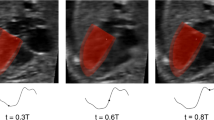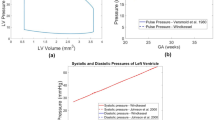Abstract
Finite Element simulations are a robust way of investigating cardiac biomechanics. To date, it has only been performed with the left ventricle (LV) alone for fetal hearts, even though results are likely different with biventricular (BiV) simulations. In this research, we conduct BiV simulations of the fetal heart based on 4D echocardiography images to show that it can capture the biomechanics of the normal healthy fetal heart, as well as those of fetal aortic stenosis better than the LV alone simulations. We found that performing LV alone simulations resulted in overestimation of LV stresses and pressures, compared to BiV simulations. Interestingly, inserting a compliance between the LV and right ventricle (RV) in the lumped parameter model of the LV only simulation effectively resolved these overestimations, demonstrating that the septum could be considered to play a LV-RV pressure communication role. However, stresses and strains spatial patterns remained altered from BiV simulations after the addition of the compliance. The BiV simulations corroborated previous studies in showing disease effects on the LV, where fetal aortic stenosis (AS) drastically elevated LV pressures and reduced strains and stroke volumes, which were moderated down with the addition of mitral regurgitation (MR). However, BiV simulations enabled an evaluation of the RV as well, where we observed that effects of the AS and MR on pressures and stroke volumes were generally much smaller and less consistent. The BiV simulations also enabled investigations of septal dynamics, which showed a rightward shift with AS, and partial restoration with MR. Interestingly, AS tended to enhance RV stroke volume, but MR moderated that down.















Similar content being viewed by others
References
Amin P, Levi DS, Likes M, Laks H (2009) Pulmonary atresia with intact ventricular septum causing severe left ventricular outflow tract obstruction. Pediatr Cardiol 30:851–854
Asner L et al (2017) Patient-specific modeling for left ventricular mechanics using data-driven boundary energies. Comput Methods Appl Mech Eng 314:269–295. https://doi.org/10.1016/j.cma.2016.08.002
Bayer JD, Blake RC, Plank G, Trayanova NA (2012) A novel rule-based algorithm for assigning myocardial fiber orientation to computational heart models. Ann Biomed Eng 40:2243–2254. https://doi.org/10.1007/s10439-012-0593-5
Calvert JW, Lefer DJ (2012) Chapter 6—Overview of Cardiac Muscle Physiology. In: Hill JA, Olson EN (eds) Muscle. Academic Press, Boston, pp 57–66. https://doi.org/10.1016/B978-0-12-381510-1.00006-5
Chuong CJ, Fung YC (1983) Three-dimensional stress distribution in arteries. J Biomech Eng 105:268–274. https://doi.org/10.1115/1.3138417
Clancy DJ, Mclean A, Slama M, Orde SR (2018) Paradoxical septal motion: a diagnostic approach and clinical relevance Australasian. J Ultrasound Med 21:79–86
Dewan S et al (2017) Model of human fetal growth in hypoplastic left heart syndrome: reduced ventricular growth due to decreased ventricular filling and altered shape. Front Pediatr 5:25
Donofrio MT et al (2014) Diagnosis and treatment of fetal cardiac disease. Circulation 129:2183–2242. https://doi.org/10.1161/01.cir.0000437597.44550.5d
Emmanuel Y, Thorne SA (2015) Heart disease in pregnancy. Best Pract Res Clin Obstet Gynaecol 29:579–597. https://doi.org/10.1016/j.bpobgyn.2015.04.002
Finsberg H et al (2018) Efficient estimation of personalized biventricular mechanical function employing gradient-based optimization. Int J Numer Methods Biomed Eng 34:e2982. https://doi.org/10.1002/cnm.2982
Green L, Chan WX, Ren M, Mattar CNZ, Lee LC, Yap CH (2023) The dependency of fetal left ventricular biomechanics function on myocardium helix angle configuration. Biomech Model Mechanobiol 22:629–643
Guccione JM, Waldman LK, McCulloch AD (1993) Mechanics of active contraction in cardiac muscle: Part II—Cylindrical models of the systolic left ventricle. J Biomech Eng 115:82–90. https://doi.org/10.1115/1.2895474
Henderson Y, Prince A (1914) The relative systolic discharges of the right and left ventricles and their bearing on pulmonary congestion and depletion. Heart 5:1913–1914
Johnson P, Maxwell DJ, Tynan MJ, Allan LD (2000) Intracardiac pressures in the human fetus. Heart 84:59–63. https://doi.org/10.1136/heart.84.1.59
King M, Braun H, Goldblatt A, Liberthson R, Weyman A (1983) Interventricular septal configuration as a predictor of right ventricular systolic hypertension in children: a cross-sectional echocardiographic study. Circulation 68:68–75
Lumens J, Delhaas T, Kirn B, Arts T (2009) Three-wall segment (TriSeg) model describing mechanics and hemodynamics of ventricular interaction. Ann Biomed Eng 37:2234–2255. https://doi.org/10.1007/s10439-009-9774-2
Mäkikallio K et al (2006) Fetal aortic valve stenosis and the evolution of hypoplastic left heart syndrome: patient selection for fetal intervention. Circulation 113:1401–1405
Naeije R, Badagliacca R (2017) The overloaded right heart and ventricular interdependence. Cardiovasc Res 113:1474–1485. https://doi.org/10.1093/cvr/cvx160
Nelson GS, Sayed-Ahmed EY, Keurs HEDJT, Tyberg JV, Shrive NG (2001) A 2D finite element model of the interventricular septum under normal and abnormal loading. Comput Methods Biomech Biomed Eng 4:307–322. https://doi.org/10.1080/10255840108908011
Ohayon J, Usson Y, Jouk PS, Cai H (1999) Fibre orientation in human fetal heart and ventricular mechanics : a small perturbation. Comput Methods Biomech Biomed Eng 2:83–105. https://doi.org/10.1080/10255849908907980
Ong CW et al (2021) Biomechanics of human fetal hearts with critical aortic stenosis. Ann Biomed Eng 49:1364–1379. https://doi.org/10.1007/s10439-020-02683-x
Pennati G, Fumero R (2000) Scaling approach to study the changes through the gestation of human fetal cardiac and circulatory behaviors. Ann Biomed Eng 28:442–452
Pennati G, Bellotti M, Fumero R (1997) Mathematical modelling of the human foetal cardiovascular system based on Doppler ultrasound data. Med Eng Phys 19:327–335. https://doi.org/10.1016/S1350-4533(97)84634-6
Picazo-Angelin B, Zabala-Argüelles JI, Anderson RH, Sánchez-Quintana D (2018) Anatomy of the normal fetal heart: the basis for understanding fetal echocardiography. Ann Pediatr Cardiol 11:164
Scardulla F et al (2018) Modeling right ventricle failure after continuous flow left ventricular assist device: a biventricular finite-element and lumped-parameter analysis cardiovascular. Eng Technol 9:427–437. https://doi.org/10.1007/s13239-018-0358-x
Shavik SM, Wall ST, Sundnes J, Burkhoff D, Lee LC (2017) Organ-level validation of a cross-bridge cycling descriptor in a left ventricular finite element model: effects of ventricular loading on myocardial strains. Physiol Rep 5:e13392. https://doi.org/10.14814/phy2.13392
Shavik SM, Zhong L, Zhao X, Lee LC (2019) In-silico assessment of the effects of right ventricular assist device on pulmonary arterial hypertension using an image based biventricular modeling framework. Mech Res Commun 97:101–111. https://doi.org/10.1016/j.mechrescom.2019.04.008
Tobon-Gomez C et al (2013) Benchmarking framework for myocardial tracking and deformation algorithms: an open access database. Med Image Anal 17:632–648
Tulzer A, Arzt W, Tulzer G (2021) Fetal aortic valvuloplasty may rescue fetuses with critical aortic stenosis and hydrops. Ultrasound Obstet Gynecol 57:119–125. https://doi.org/10.1002/uog.22138
Tulzer A, Arzt W, Gitter R, Sames-Dolzer E, Kreuzer M, Mair R, Tulzer G (2022) Valvuloplasty in 103 fetuses with critical aortic stenosis: outcome and new predictors for postnatal circulation. Ultrasound Obstet Gynecol 59:633–641
Weyman AE, Wann S, Feigenbaum H, Dillon JC (1976) Mechanism of abnormal septal motion in patients with right ventricular volume overload: a cross-sectional echocardiographic study. Circulation 54:179–186. https://doi.org/10.1161/01.CIR.54.2.179
Wiputra H, Lim GL, Chia DAK, Mattar CNZ, Biswas A, Yap CH (2016) Methods for fluid dynamics simulations of human fetal cardiac chambers based on patient-specific 4D ultrasound scans. J Biomech Sci Eng 11:15–00608-00615-00608. https://doi.org/10.1299/jbse.15-00608
Wiputra H, Chan WX, Foo YY, Ho S, Yap CH (2020) Cardiac motion estimation from medical images: a regularisation framework applied on pairwise image registration displacement fields. Sci Rep 10:18510. https://doi.org/10.1038/s41598-020-75525-4
Wong HS, Li B, Tulzer A, Tulzer G, Yap CH (2023) Fluid mechanical effects of fetal aortic valvuloplasty for cases of critical aortic stenosis with evolving hypoplastic left heart syndrome. Ann Biomed Eng. https://doi.org/10.1007/s10439-023-03152-x
Yudkowitz FS (2015) Fetal-Neonatal Physiology and Circulation. In: Santos AC, Epstein JN, Chaudhuri K (eds) Obstetric Anesthesia. McGraw-Hill Education, New York
Acknowledgements
Funding for this study is provided by Singapore Ministry of Education, Tier 2 Grant (MOE2018-T2-1-003), and Imperial College startup funding.
Author information
Authors and Affiliations
Contributions
MR, CHY derived conceptualized the study. MR, WXC, LG developed the methodology and performed investigations and formal analysis. MB and CHY performed supervision and project administration. MR, CHY drafted the original manuscript. All authors reviewed and edited the manuscript.
Corresponding authors
Ethics declarations
Competing interests
The authors declare no competing interests.
Additional information
Publisher's Note
Springer Nature remains neutral with regard to jurisdictional claims in published maps and institutional affiliations.
Supplementary Information
Below is the link to the electronic supplementary material.
Supplementary file2 (MP4 2540 kb)
Supplementary file3 (MP4 2480 kb)
Rights and permissions
Springer Nature or its licensor (e.g. a society or other partner) holds exclusive rights to this article under a publishing agreement with the author(s) or other rightsholder(s); author self-archiving of the accepted manuscript version of this article is solely governed by the terms of such publishing agreement and applicable law.
About this article
Cite this article
Ren, M., Chan, W.X., Green, L. et al. Biventricular finite element modeling of the fetal heart in health and during critical aortic stenosis. Biomech Model Mechanobiol (2024). https://doi.org/10.1007/s10237-024-01842-6
Received:
Accepted:
Published:
DOI: https://doi.org/10.1007/s10237-024-01842-6




